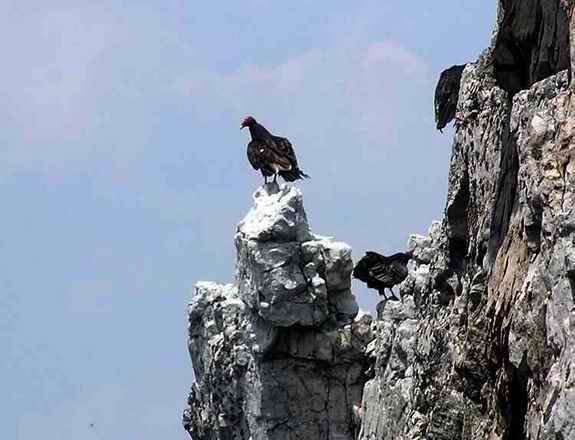|
Return to Hiker's Notebook Home Page
Common Name: Turkey Vulture, Turkey Buzzard, Carrion Crow, John Crow - Named for the domestic American turkey due to the naked red coloration of the featherless head of both birds. Vulture is from the Latin vuellere, to pluck or tear out, referring to the manner in which carrion food is consumed. Scientific Name: Cathartes aura - The generic name is from the Greek katharsis meaning purification, purportedly in reference to its consumption of carrion that purifies the land of decaying flesh. The species name is probably from the Latin word for breeze and refers to the soaring of the bird in updrafts. It may also be from aurum, the Latin word for gold or for a Latinized version of the South American word for vulture.
The lack of a systematic method for the assignation of common names for the flora and fauna discovered by the early colonists to the Americas has resulted in a tangled etymological history. The turkey and its namesake turkey vulture are good examples of this. The domestication of the turkey (Meleagris gallopavo) probably began in Mexico whence the birds were imported to Europe by the Spanish in the 16th Century. A similar bird widely domesticated in Europe was called the Guinea fowl for its origination, the Guinea coast of Africa. It was also known as the turkey-cock as it was imported by way of Turkey, a metonymy for the Islamic lands. When the American-Spanish turkey became popular in England, it was also called the turkey-cock since it resembled the Guinea fowl. The shortened name turkey was retained when it was reintroduced to the North American English colonies in the 17th century. So the turkey is named for Turkey. The term buzzard was used by the early colonists as a synonym for vulture.
The turkey vulture uses sight significantly augmented by its acute sense of smell to locate carrion, the decaying flesh of a dead carcass. Unlike the Old World vultures of Africa and Asia that are descended from the hawks and eagles with essentially nonexistent olfactory capabilities, the New World turkey vulture descended from the storks and ibises with a pronounced sense of smell. Turkey vultures are attracted by the smell of mercaptan, one of the gasses emitted during carrion decomposition. Ethyl mercaptan is added to natural gas to provide a means of leak detection from the otherwise odorless substance. Engineers were sometimes able to find pipeline leaks when turkey vultures were seen circling above the gas lines. The turkey vulture can detect concentrations in the range of parts per trillion and can discern the direction of their origin.
Turkey vultures have weaker beaks and talons than other raptors and are not well adapted to killing their prey. Although they have been known to eat young or weakened mammals and birds and even vegetative matter if carrion is scarce, this is quite rare. There is no danger of them attacking a pet, as they will not approach a moving animal. They are surprisingly selective in their choice of meat. They will not eat carrion in advanced stages of putrefaction, preferring fresher meat. However, they must wait for several days after a carcass starts to decay in order for it to soften enough for their beaks to be able to penetrate the hide. Nor will a turkey vulture consume the carcass of any animal. As with most scavengers, they prefer the flesh of the herbivore, as it is much tastier than that of the carnivore. Therefore, they will avoid the carcasses of dogs and cats in favor of more succulent road kill.
The digestive system of the turkey vulture has become adapted to the consumption of carrion that is infested with a profusion of bacteria and viruses. Their stomachs contain digestive acids capable of killing the microorganisms that would almost certainly sicken other animals. There is evidence that they can even consume meat infected with anthrax. Their excrement is thus a sanitizer, and turkey vultures are noted for expelling their white, fluid waste onto their legs to clean them when they step away from a carcass. They will also defecate on their legs as a cooling mechanism, using the latent heat of vaporization associated with the evaporation of the water to remove heat.
Turkey vultures are readily identified in flight by the manner in which they hold their wings; at an angle called a dihedral slightly above the plane of the body. They oscillate from side-to-side to maintain stability at low altitude, their predominant flight pattern for detecting the smell of a potential food source. The characteristic of circling vultures is not necessarily an indication of a proximate dead animal. Nor do vultures circle above a dying animal. Vultures circle in the use of updrafts to gain altitude in preparation for relocation, repeating the process as needed for longer flights. They also circle on updrafts to maintain altitude while in search of food. However, the presence of a vulture in the air may be indicative of carrion. If it is a small carcass that can be consumed by a single adult, the descent will be rapid and dispatch swift. For larger carcasses, an individual may circle until joined by an adequate number of cohorts to effect rapid and complete consumption in a timely manner; each vulture consuming up to 20 percent of its weight in one sitting. The circling of vultures appears to some to be like the steam rising from boiling water in a kettle. A group of vultures is known as a kettle for this reason. |
